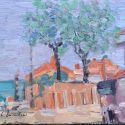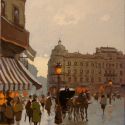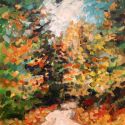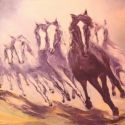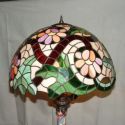The Grigore Antipa National Museum of Natural History is most likely one of the top three best known cultural institutions of Bucharest, popular among the young and the old, and for many generations it's been a symbol and a gathering place which provides everytime a fascinating and interactive experience. It is the oldest and largest museum of this kind in the region, with collections of literally hundreds of thousands of objects, among these the largest and best collection of butterflies in the world. A great place to be, very wisely organised, as it's exhibitions literally present the history of the natural world, from the beginnings to the contemporary age. An unique voyage, undertaken each day by many visitors.
It's story actually start in 1834, when the National Museum (Museul National) is opened in Bucharest by Alexandru Ghica, who was inspired by his brother, Mihalache Ghica, to found such an institution. He also made the first donation to the new museum : a collection of 1250 Greek, Roman and Bizantine coins, 150 minerals and 213 shells. Also, Mihalache Ghica donated to the museum several fish, birds, mamals and fossils, which show him to be a natural history collector and amateur scientist. The first director and curator of the museum was Carol Wallenstein de Vella, from Austria, appointed in 1837. He was followed by Carlo Ferreratti, in 1860. Three years later the museum was moved in three halls, on the left side of the Academy Palace in Bucharest.
In 1864 Alexandru Ioan Cuza was the one who aproved the new roles for organising the National History Museum of Bucharest. It was the first set of rules that clearly stated how the institution was run, what was the role of the director, of the curators, how new acquisitions were made, which were the visiting hours. All in all, for the first time a museum of this kind and importance was run according to a law.
In the summer of 1867 the collections were once again moved, after Gregoriu Stefanescu, a Geology and Paleonthology profesor at the University in Bucharest was appointed the new director. This time, the exhibits were moved in three hall in the building of the University. Stefanescu remained the director of the institution until 1893 and further enriched it's collections. In 1882 the museum received an important donation from Hilarie Mitrea, a collector and natural history passionate, who gave an impressive selection from his "treasure". In whole, there were over one thousand species of animals, from insects and fishes, to reptiles, birds, mammals, all very well prepared. Due to space constraints, most of these small treasures were kept in storage until 1894, when Grigore Antipa would take over the museum. It still is the largest and most valuable donation ever received by the Museum in it's long history. Some of the best collections were destroyed in 1884, in a devastating fire that affected the University, and many of the plants and fossils were lost.
On April 1st 1893 the museum entered a new phase in it's development, when a certain Grigore Antipa was appointed the new director of the Zoology section of the institution, by Take Ionescu, then the Ministry of Culture. Little was known that Grigore Antipa will run the whole museum for 51 one years, eventually lending his name to it. Exactly one year later, a new house was rented, on Polona Street, No 19, for the museum's collections of zoology. Antipa also began reorganising the museum, opening the Anthropology and Ethnography sections. In 1895 Antipa hired Robert Ritter von Dombrovski as a curator, and the two will work together for more than two decades, Dombrovski even contributing to the first dioramas. Another important member of the team will be Arnold Lucien Montandon, a French naturalist, who would work for the museum until 1907. Montandon would work mainly in buildings the insect collections. After several years of running the museum, Grigore Antipa requested the opening of a Natural History Museum "worthy of Bucharest, the nation's capital". Although it wasn't the best of times, financially speaking, his request was aproved and the sum of 350.000 Lei was prepared for this ambitious project. The spot, 23.000 squared meters wide, was chosen at the end of Kiseleff Highway.
The works on the future buildings began in 1904, the project being signed by the architect Mihail Rocco, who would also supervise every step of the way. The facade, still impressive, was the creation of Grigore Cerchez. Everything was ready by 1906, and the museum was ready for it's collections and visitors. Several tens of thousands of exhibits were moved into the new location and the whole team, with Antipa included, worked in a strenous manner, preparing everything for the grand opening. This grand opening would take place on May 24th 1908, in the presence of King Carol I, Prince Ferdinand and Queen Maria. There were 16 halls, among which one had 4 dioramas, among the first in the world and of great quality. After that, the collection of the National Museum of Natural History further enriched.
In 1911 the skeleton of the Deinotherium gigantissimum (one of the best exhibits) was brought in the museum ; in 1914 several new sections were opened, such as Anthropology, General Ethnography and others ; the team continued to acquire other pieces and rare exhibits, making the museum one of the best in the world. On 23 May 1933 the passing of 100 years since the founding of the Museum was marked in the central hall with a solemn meeting, presided by King Carol II. Grigore Antipa had been the director and the main organiser for 40 years, and the new building had been used for a quarter of a century. From a small, dusty museum, Antipa managed to turn the institution into a new and modern place. Therefore, it seemed only just for the king to decreee that the museum will bear the name of Grigore Antipa National Museum of Natural History. A name that remained and is today a trademark.
The Second World War wasn't too kind on the Museum's building and activities. The building was severely damaged in the earthquake of 1940 and further damaged during the Allied bombings. Unfortunatelly for everyone, on March 9th 1944 Grigore Antipa passed away, 77 years old, after a lifetime of hard and passionate work. The new director was Mircea Pauca, followed by Constantin Motas (1945). Starting with 1948 the exhibits presenting Romania's fauna were presented separately, in 5 halls, and at ground level a new hall was opened, for conferences. After several renovations and changes, the museum was reopened in 1949.
In 1951 - 1964 the Grigore Antipa National Museum of Natural History was run but several important scientists, manu of them also professors at the Biology College : Bernard Schnapp (1951 - 1955), Alexandru Grosu (1955 - 1957), Mihai Ionescu (1957 - 1959), Petre Raicu (1959 - 1961), Mircea Ionescu-Varo (1961 - 1964). It's collections further grew, every Sunday the museum presented a public conference, and more and more visitors came through the huge doors. In 1957 the building was once again renovated and two new wings were built next to the central part. The same year the first number of the museums's magazine was published, "Travaux du Museum d'Histoire Naturelle Grigore Antipa".
Mihai Bacescu became the new director of the museum in 1964 and in November 1973 - February 1974 the first scientific expedition took place. Led by Mihai Bacescu, the team of scientists went to Tanzania, gathering a great number of animals, which further enriched the museum's collections. In 1977 the building was severely damaged by the earthquake, and it would take several months of hard work for the museum to completely reopen. In 1988 Dumitru Murariu became the new director, and managed, despite the political regime, to keep the interest alive and make some new acquisitions. Also, the 1980's brought another change, as the pupils and students could attend classes for free, discovering the magic of nature.
The next foreign exhibition was in February - June 1991, when the team of four specialists left for Indonesia, where it collected several important future exhibits. Three years later another trek took place, this time in Brasil. In November 1996 the building was renovated and strenghtened and it would be until 1999 that only part of the museum reopened. The whole museum will once again reopen only in 2006, after an intensive advertising campaign, to promote it's role as one of the most important public institutions in Romania, a place where interest for science, impressive exhibits and higher learning went hand in hand.
Grigore Antipa National Museum of Natural History is one of the most popular museum in Bucharest - and in Romania - and one of the best in it's class in the whole world. But it is also a very modern institution, with a website (rather well made), a great number of interactive programs for children and youngsters, a great number of good exhibits and especially dioramas.
Photo : cimec.ro
2007-11-20



